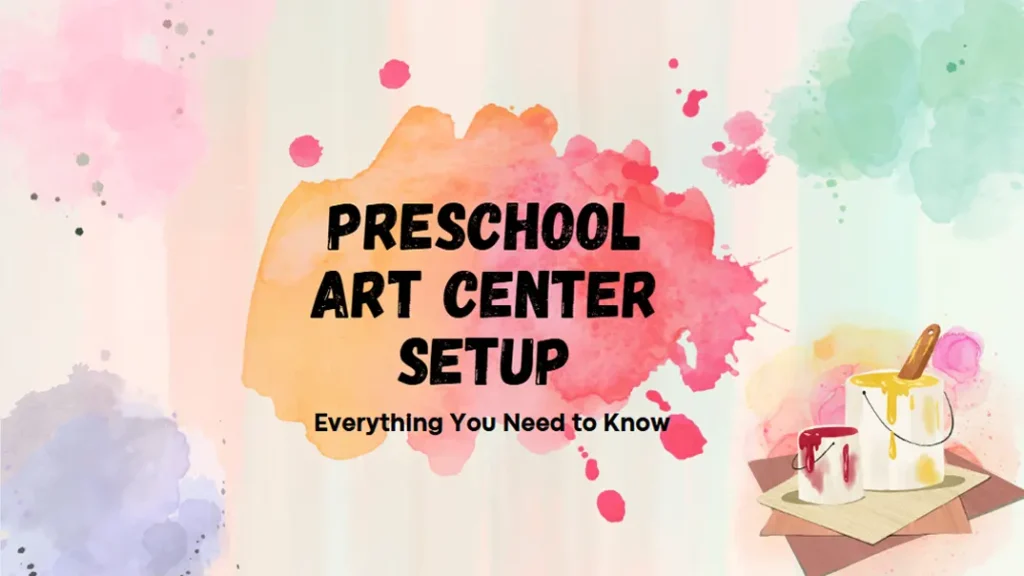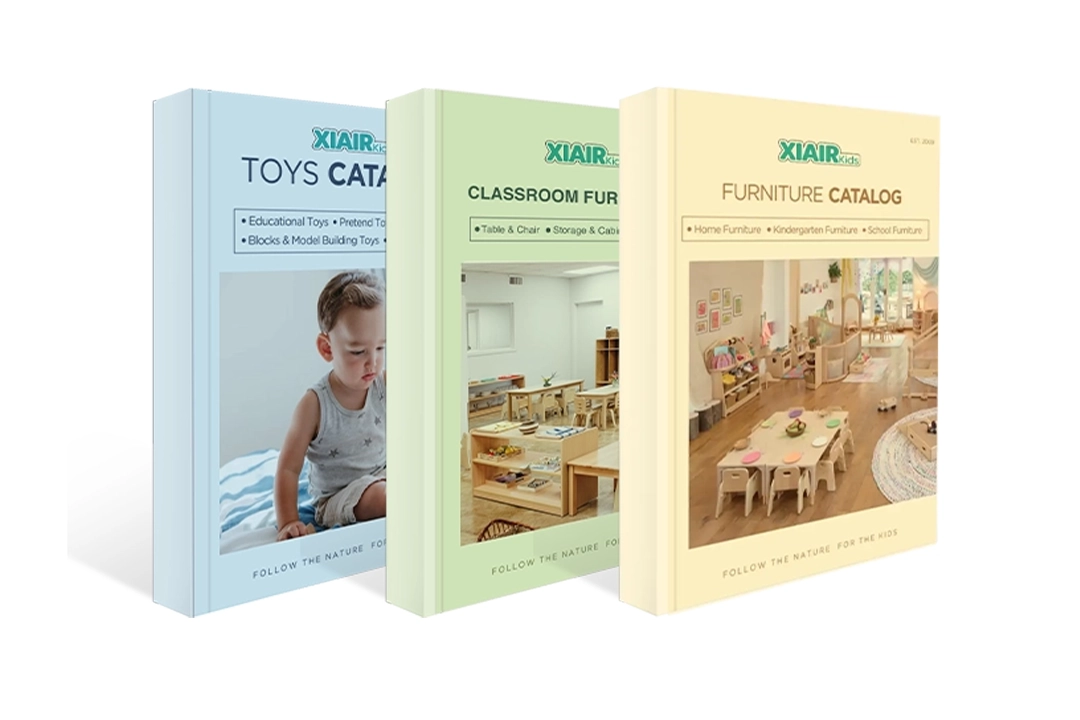How do you create a preschool art center that truly supports learning and creativity? Many educators ask: What materials do I need for a preschool art center? Or, how do I create an inspiring space without overwhelming young children? These are typical concerns when planning a preschool art center that balances creativity, functionality, and safety.
A preschool art center is a thoughtfully designed area within the classroom where young children can explore various forms of artistic expression, including drawing, painting, cutting, gluing, and crafting. It is more than just a place to store supplies; it serves as a dynamic learning environment that promotes fine motor skills, emotional expression, and cognitive development.
By understanding the elements of an effective art center, such as age-appropriate materials, a convenient layout, and defined creative areas, you can build a preschool art center that fosters both independence and imagination. Keep reading to unlock practical strategies and tips that will bring your preschool art center to life.
Why Is the Art Center Important in Preschool?
The preschool art center is a cornerstone of early childhood education. Within this creative environment, children are encouraged to explore ideas, express emotions, develop physical coordination, and build essential life skills. A well-designed art center supports the whole child by contributing to cognitive, social, emotional, and physical development in ways that are both meaningful and lasting.
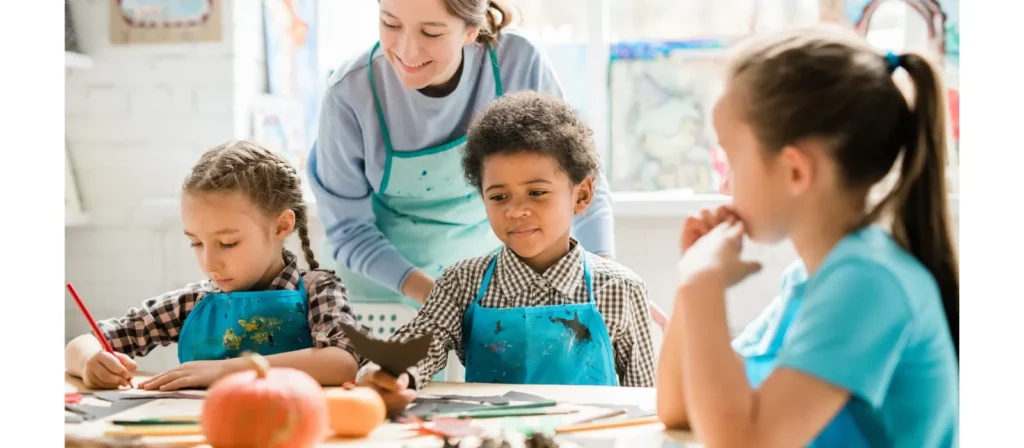
1. Promotes Fine Motor Skills and Cognitive Growth
The art center plays a vital role in strengthening motricité fine. Activities like cutting with scissors, holding a paintbrush, or gluing materials require small, precise movements that build hand-eye coordination and finger strength, both of which are critical for later writing tasks. At the same time, artistic creation stimulates the brain, supporting early cognitive functions such as memory, sequencing, and problem-solving.
2. Encourages Emotional Expression and Self-Regulation
Not all preschoolers can express their thoughts and emotions verbally, but through art, they find a natural and safe outlet. Whether using colors to represent feelings or crafting a scene from their imagination, children use the art center to process experiences and build emotional awareness. Art also promotes self-regulation by teaching patience, persistence, and coping skills during challenging creative tasks.
3. Builds Social and Communication Skills
Art centers are collaborative by nature. Children share materials, observe each other’s work, and often engage in conversation while creating. These interactions help them learn social skills like taking turns, cooperating, and respecting others’ ideas. Talking about their artwork further supports language development as they learn to describe their creations, tell stories, and ask questions.
4. Fosters Creativity and Independent Thinking
Unlike structured academic tasks, the art center offers open-ended experiences where children can make their own choices, test their ideas, and explore without fear of failure. This type of creative freedom builds confidence and nurtures a mindset of curiosity and innovation. Over time, children begin to see themselves as capable creators with unique voices.
5. Integrates with Other Areas of Learning
The preschool art center connects naturally with multiple learning domains. Exploring shapes, patterns, and symmetry supports early math concepts. Mixing colors, working with natural materials, or observing changes in texture can encourage scientific thinking. Storytelling through pictures and illustrations helps strengthen literacy. This interdisciplinary nature makes the art center a valuable part of any balanced preschool curriculum.
What a Successful Preschool Art Center Should Look Like?
A successful preschool art center is more than just a space filled with materials. It is an environment designed to foster creativity, independence, and developmental growth, all while maintaining organization and safety. Let’s explore the key characteristics that make an art center effective and engaging for preschoolers.
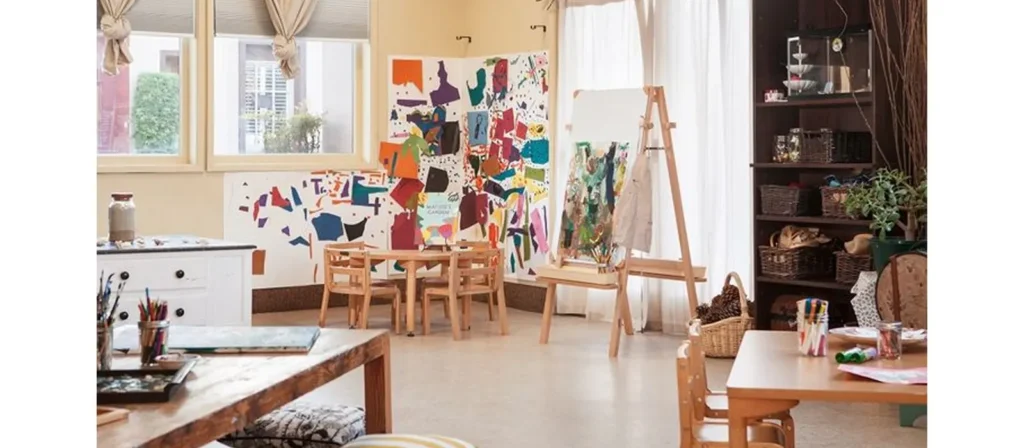
- Welcoming and Inspiring Atmosphere
Bright, stimulating colors and open spaces that inspire curiosity. Display children’s artwork and use natural light to create a positive, motivating environment. - Clear and Defined Zones
Organized areas for different activities (e.g., drawing, painting, crafting) that are easily accessible, with visual labels or dividers for navigation. - Age-Appropriate Materials and Tools
Non-toxic, safe materials like jumbo crayons, blunt scissors, and washable paints that match the developmental skills of preschoolers. - Encouragement of Open-Ended Creativity
Materials and activities that allow children to experiment freely, focusing on the process of creating rather than the finished product. - Clean and Safe Environment
Properly stored materials, easy-to-clean surfaces, and clear routines for managing the space to ensure safety and cleanliness. - Teacher Involvement and Guidance
Teachers facilitate creativity by offering choices, asking questions, and modeling appropriate tool use, fostering independent exploration.
How to Set Up Your Preschool Art Center?
Designing a preschool art center is not just about placing supplies in a corner—it requires planning to create a space that encourages creativity, supports development, and fits seamlessly into the classroom. Below are the essential dimensions to consider when building a functional and engaging art center for preschoolers.
1. Start With a Vision and a Plan
Before arranging mobilier de classe or buying materials, visualize what you want your preschool art center to achieve. Is it a place for messy exploration, calm creativity, or both? Consider how much space you have, what age group you’re working with, and how you’ll manage the flow of traffic and materials. Sketch a simple layout to organize your thoughts.
2. Create a Logical Flow
Arrange the zones in a sequence that matches how children naturally work through an art project:
- Inspiration/Entry – Where they get ideas
- Sélection des matériaux – Where they gather supplies
- Work Area – Where they create
- Drying and Display – Where they finish and show work
- Cleanup – Where they tidy up
This logical flow minimizes congestion and helps children understand what comes next.
3. Choose the Right Location in the Classroom
Start by identifying a space that is naturally well-lit and easy to supervise. Ideally, this area should be close to a sink or hand-washing station to simplify cleanup after messy projects. Avoid placing the art center next to nap or reading zones to minimize disruption.
Key considerations include:
- Proximity to natural light or overhead lighting
- Easy access for both teachers and students
- Enough room for 3–5 children to work comfortably at once
Votre salle de classe idéale est à un clic !
4. Select Appropriate Furniture and Layout
Preschool furniture in the art center should be age-appropriate, durable, and easy to clean. Keep the layout open enough for movement but structured enough to support focus and safety.
Recommended pieces:
- Low tables: Easy for children to sit or stand while working
- Child-sized chairs: Match preschooler proportions
- Double-sided easels: Space-saving and allow for simultaneous use
- Storage shelves or carts: Open, labeled, and accessible
- Rugs: Define the area and make it feel cozy and inviting.
Use shelves or carts to naturally separate zones, creating flow without blocking supervision. Modular or mobile pieces offer flexibility as needs change.

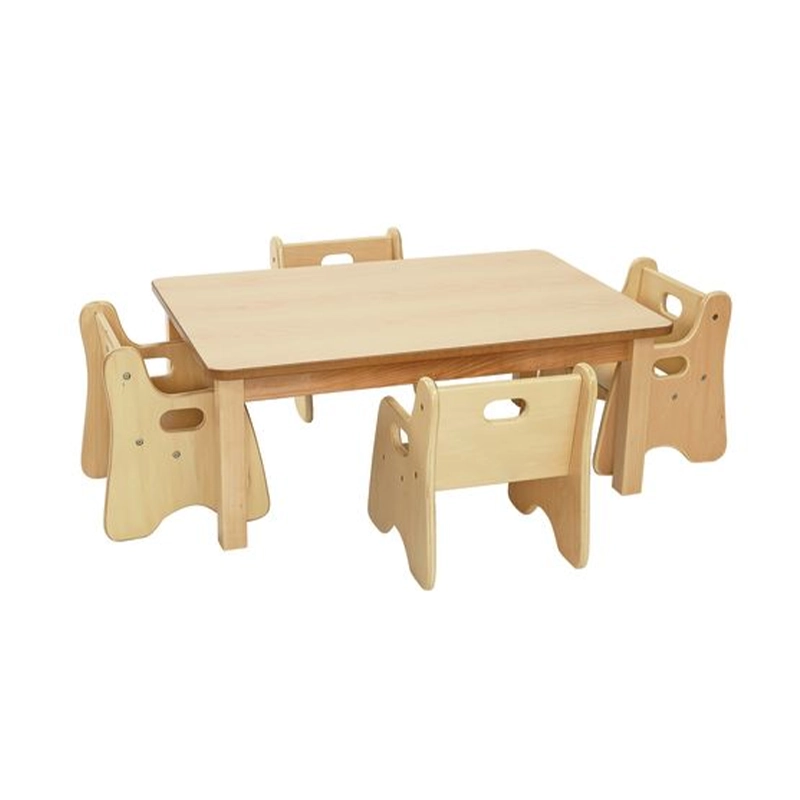

5. Define Functional Zones in Your Preschool Art Center
A well-structured art center benefits from clearly divided activity zones. Each zone should support a different type of creative task while encouraging independence and focused engagement.
Drawing and Painting Zone
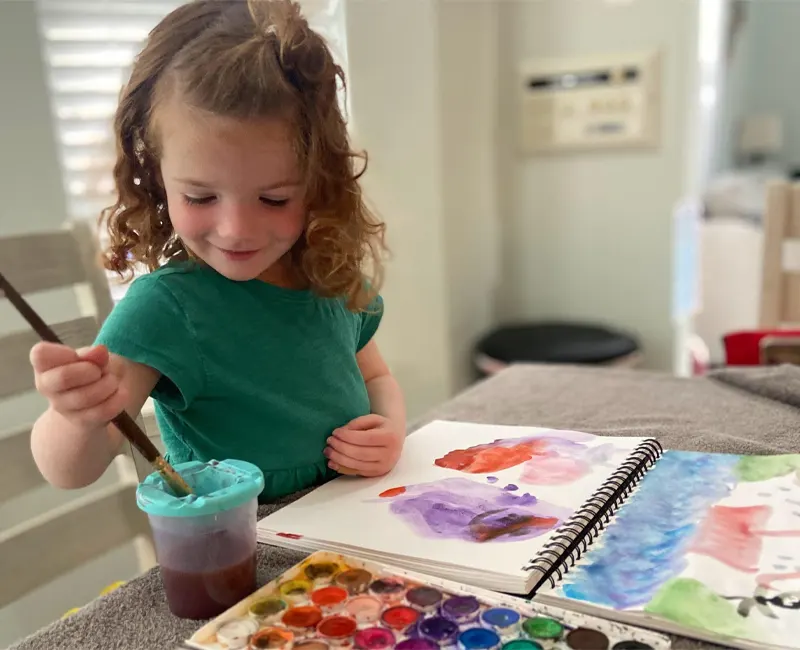
This zone is the creative heart of the preschool art center, where children express their ideas through color, line, and form. It includes tools like crayons, markers, colored pencils, and various types of paint, offering multiple ways to explore visual storytelling. The space should be well-lit, with both easel and table options to accommodate different preferences.
Collage and Craft Zone
The collage and craft zone focuses on assembling, layering, and constructing with various textured materials. Children use scissors, glue, recycled items, and decorative supplies to create artwork. This area supports hand-eye coordination and problem-solving while encouraging children to think creatively about combining different materials into unique designs.
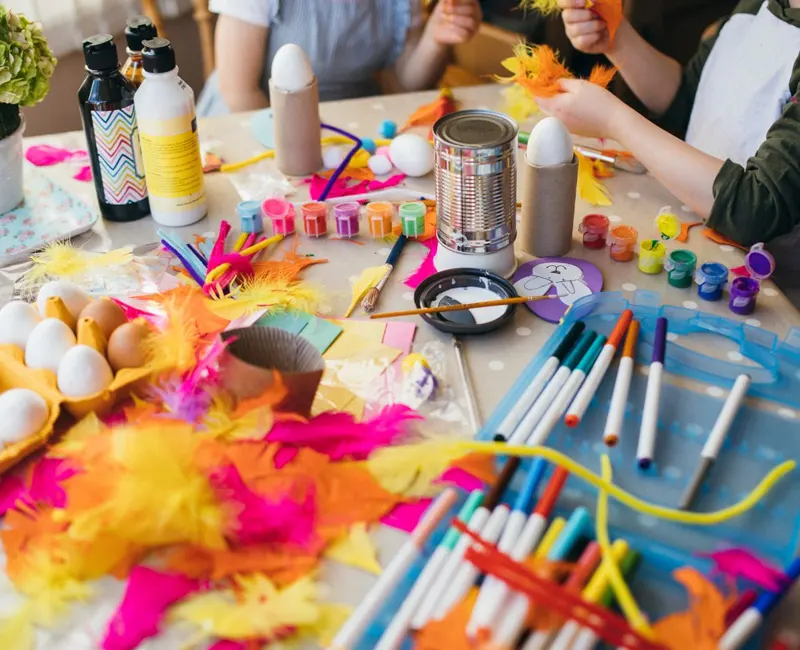
Clay and Tactile Exploration Zone
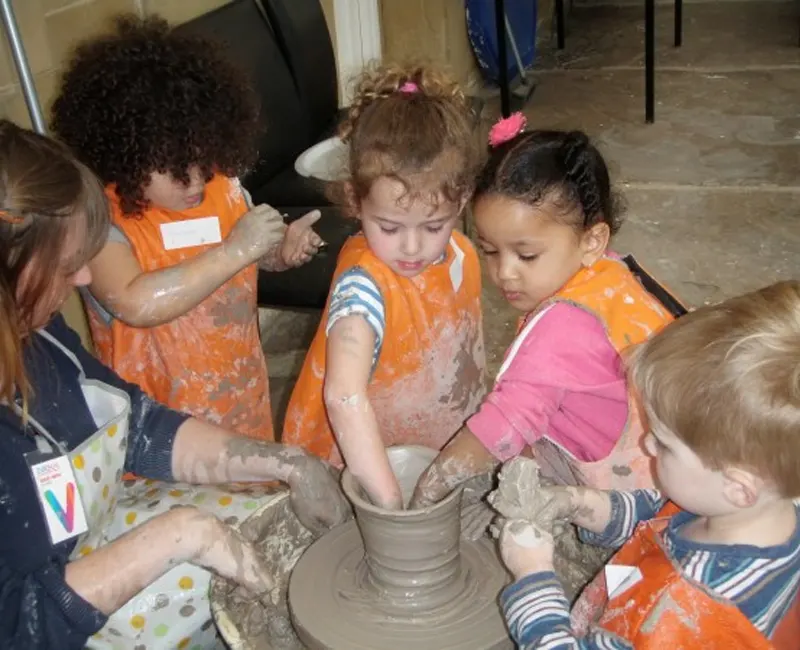
In this zone, children engage in sensory-rich experiences using clay, playdough, or other moldable materials. The hands-on nature of this area enhances tactile awareness, hand strength, and spatial reasoning as children roll, press, and sculpt their creations. It also provides a calming, therapeutic outlet for self-regulation and open-ended exploration, making it a vital part of the preschool art center.
Drying and Display Zone
This functional zone provides space for artworks to dry safely and for finished pieces to be proudly exhibited. A dedicated drying rack or shelf helps protect wet projects from smudges or damage. Meanwhile, the display area gives children a sense of pride and recognition, reinforcing the value of their creative efforts. Displaying art also boosts self-esteem and invites peer engagement.
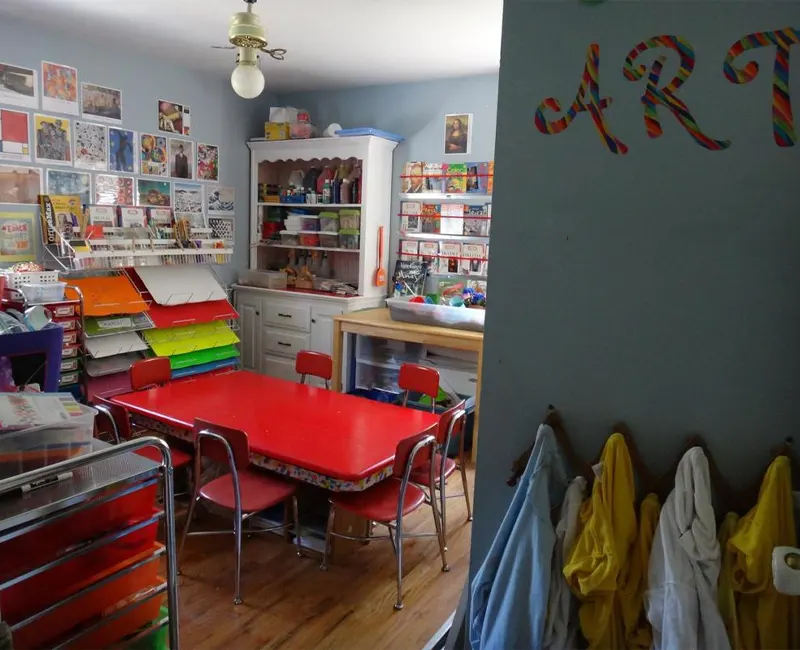
6. Art Storage Solutions
Effective storage is the backbone of a successful preschool art center. Without a system to manage materials, even the most creative space can quickly become overwhelming and disorganized. Smart storage solutions make it easier for children to access what they need, clean up independently, and take ownership of the creative process.
- Use open shelving and labeled containers:
Low, open shelves allow children to see and reach materials without assistance. Clear plastic bins, trays, or baskets with picture-word labels help even pre-readers find what they need and return it to the correct place. - Group materials by function and frequency of use:
Store everyday items like crayons, glue, and paper at child height. Keep less frequently used supplies—such as seasonal decorations or teacher-only materials—on higher shelves or in locked cabinets. - Incorporate mobile storage:
Rolling carts or portable caddies allow you to move materials between zones or even from one classroom to another. This flexibility is especially useful in shared spaces or small classrooms. - Provide individual and communal storage options:
Use cubbies or folders for children’s in-progress work, and provide designated class bins for shared items. This helps children keep track of their own creations while learning to collaborate. - Designate a restocking and overflow area:
Keep a teacher-managed cabinet or closet nearby with bulk materials like paint bottles, paper reams, and backup supplies. Regularly rotate fresh materials into the preschool art center to keep it engaging without overcrowding the space.
Votre salle de classe idéale est à un clic !
7. Create Visual Inspiration and Display Areas
A preschool art center should feel like a space that celebrates imagination. Adding visual stimuli encourages new ideas and artistic confidence.
Suggestions include:
- Display children’s recent work on a rotating bulletin board
- Post famous artworks or classroom-themed images for reference
- Use a “What Can You Make?” board with prompts, materials, or seasonal ideas
Displaying artwork builds pride and invites conversations about creative choices.
8. Prepare for Mess and Encourage Cleanup
Preschool art is inherently messy, but the right setup makes it manageable. Prepare for spills and smudges by using the right materials and teaching cleanup routines.
Best practices:
- Use washable, non-toxic supplies only
- Provide aprons or smocks in a hanging rack
- Cover the floor with a vinyl mat or an easy-to-clean rug
- Keep paper towels, wipes, and broom/dustpan nearby (teacher-only use)
- Teach children to clean their area as part of the process
9. Flexibility and Seasonal Rotation
A great preschool art center grows with your curriculum and the children’s abilities. Maintain flexibility by designing with rotation and adaptability in mind.
Ideas to try:
- Use mobile furniture that can be rearranged
- Rotate materials based on seasons, holidays, or weekly themes
- Add a “featured project” corner with materials related to current classroom topics
This keeps the preschool art center fresh and relevant without requiring constant overhaul.
10. Consider Inclusion and Accessibility
Ensure the space welcomes all children, including those with developmental or physical needs.
Inclusive design tips:
- Use adaptive tools (e.g., chunky crayons, easy-grip scissors)
- Keep walkways wide and free of obstacles
- Provide visual schedules or task cards for guided projects
- Offer sensory-friendly materials for children with sensitivities
Inclusivity in the preschool art center promotes confidence and equal participation for every learner.
11. Make the Art Center a Bridge to the Curriculum
Integrate your preschool art center with classroom themes, books, and subjects. This not only reinforces academic learning but also shows children that art connects to the world around them.
Examples:
- Draw insects during a unit on nature
- Use shape stamping during maths week
- Recreate a storybook scene with collage materials
By aligning projects with broader learning goals, the art center becomes more than just a place to draw—it becomes a tool for integrated learning.
Creating an Outdoor Preschool Art Center
Creating an outdoor component for your preschool art center offers new opportunities for expression, sensory exploration, and connection to nature. With the right setup, outdoor art can become a regular and enriching part of your early childhood environment.
Benefits of an Outdoor Art Space
- Supports Gross Motor Development: Children use their whole bodies when painting on vertical surfaces or working on large-scale projects, which helps strengthen coordination and balance.
- Encourages Sensory Exploration: Outdoor materials like mud, leaves, sand, and water offer natural textures and sensations that enrich children’s sensory experiences.
- Promotes Creativity and Risk-Taking: The open-air environment encourages freedom and experimentation, allowing children to be bold with their movements, ideas, and use of materials.
- Connects Art with Nature: Using natural elements such as twigs, stones, or flowers helps children see artistic value in the world around them and fosters environmental awareness.
- Reduces Mess-Related Stress: Paint splashes, clay crumbs, or water spills are easier to manage outdoors, making it less stressful for teachers and more liberating for children.
- Improves Focus and Mood: Being outdoors can reduce restlessness and boost concentration, especially for children who benefit from open space and fresh air.
- Expands the Creative Canvas: Outdoor surfaces—like fences, sidewalks, tree trunks, and walls—offer alternative “canvases” that expand artistic possibilities.
- Encourages Collaboration: Larger open areas are ideal for group art projects, promoting teamwork, communication, and shared creativity among preschoolers.
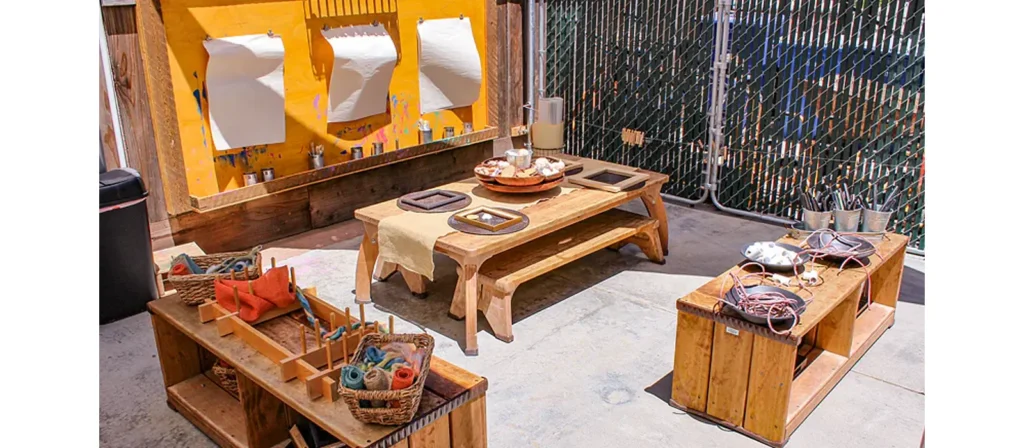
Choisir le bon emplacement
Look for a flat, shaded, and easily supervised area, such as a corner of the playground or a covered patio. Safety and visibility are key. If possible, position it near a water source for easy cleanup, and make sure it’s protected from strong wind or direct sun during peak hours.
Essential Outdoor Art Materials
Equip the space with washable, weather-tolerant materials like tempera paint, sidewalk chalk, large paper rolls, and outdoor easels. Natural brushes made from leaves or twigs can add texture and fun. Store everything in waterproof bins or portable carts for easy setup and breakdown.
Incorporating Nature into Art
Encourage children to use leaves, pebbles, flowers, sticks, or sand as tools or media. Try nature rubbings, rock painting, or land art that stays in nature. These activities blend creative expression with sensory and scientific exploration, making the preschool art center even more holistic.
Managing Outdoor Art Safely
Outdoor art spaces should be clearly defined and equipped with smocks, mats, or tarps to protect clothing and surfaces. Always provide supervision, especially when using tools or small loose parts. Be mindful of the weather and adjust activities to ensure comfort and safety.
Preschool Art Center Supplies List
This comprehensive list includes essential materials for various types of art activities, from basic drawing and painting to more advanced sculpture and collage-making. By providing a variety of age-appropriate, safe, and accessible materials, teachers can create an inspiring space that encourages young artists to engage with the world around them in imaginative ways.
Basic Art Supplies
Basic supplies are the foundation of any preschool art center, offering the essential tools for a variety of creative activities. These materials support the development of fine motor skills as children learn to grip crayons, markers, and paintbrushes and explore the world of colors and shapes.
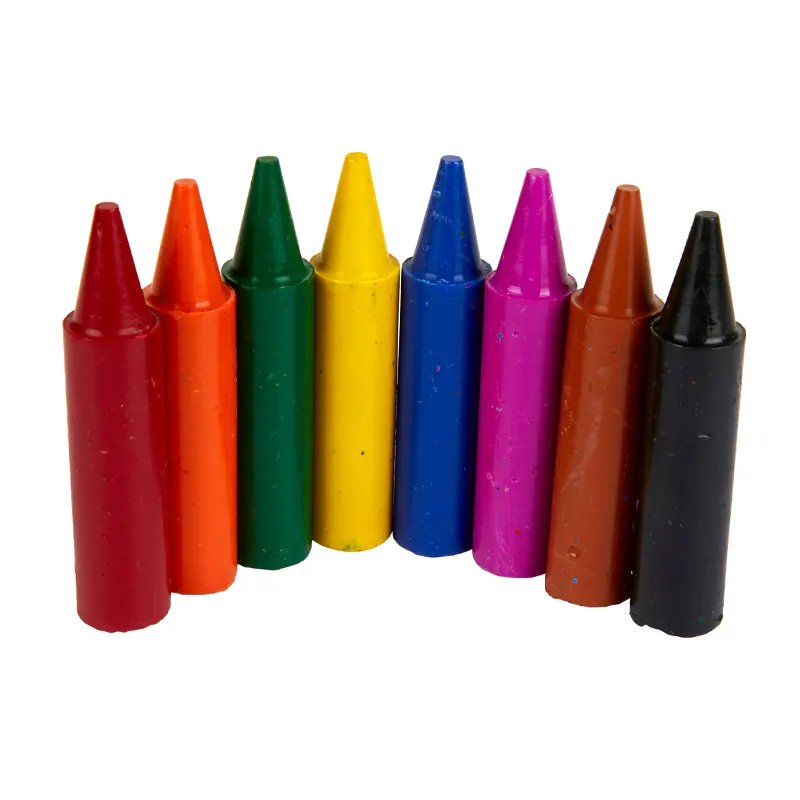
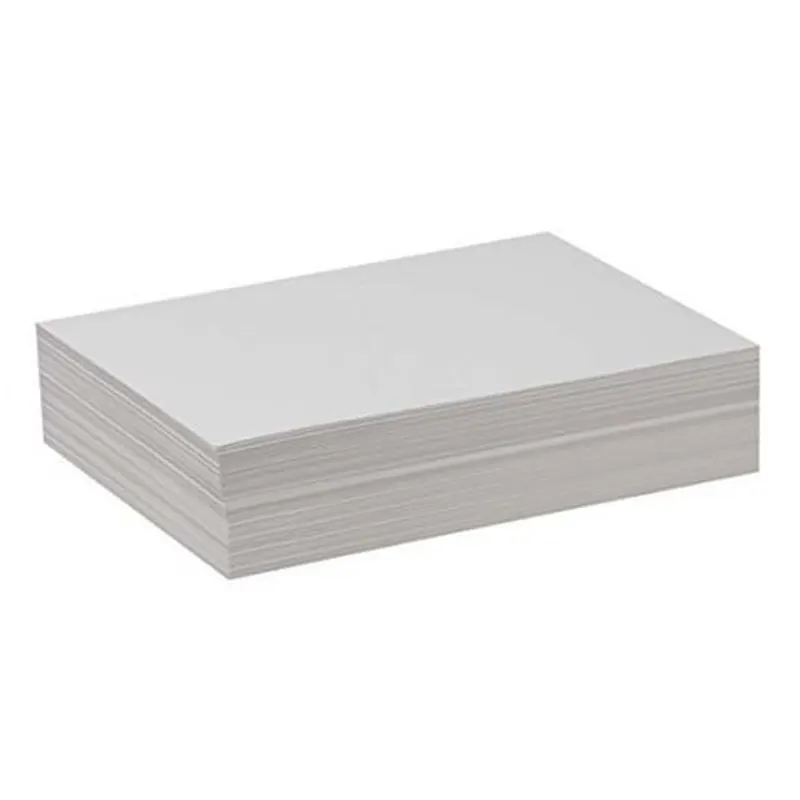
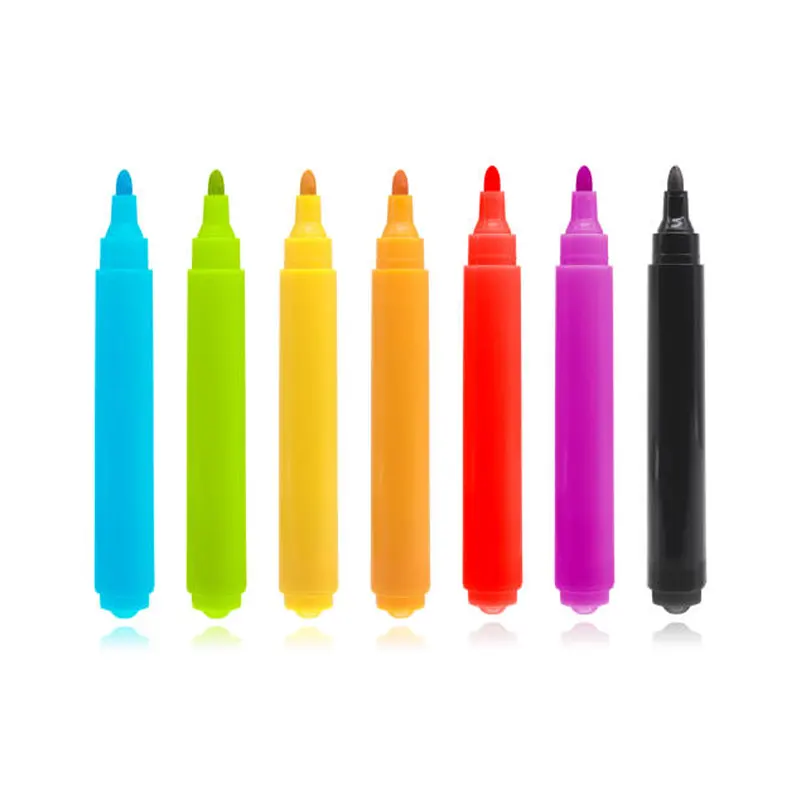
- Crayons: Available in a variety of colors, perfect for drawing and coloring activities.
- Colored Pencils: For more detailed coloring and shading exercises.
- Marqueurs: Washable and thick-tipped markers are ideal for drawing and writing.
- Watercolor Paints: Water-based paints for mixing colors and exploring different textures.
- Acrylic Paints: Non-toxic paints for older preschoolers to experiment with bold color techniques.
- Paintbrushes: Various sizes to support different painting styles.
- Drawing Paper: Large sheets for doodling, drawing, and painting projects.
- Construction Paper: Brightly colored paper for cutting and collage activities.
Votre salle de classe idéale est à un clic !
Textured and Tactile Materials
Children love to explore different textures, and tactile materials are a great way to engage their senses. These materials help improve fine motor coordination and encourage children to explore different surfaces, shapes, and textures.
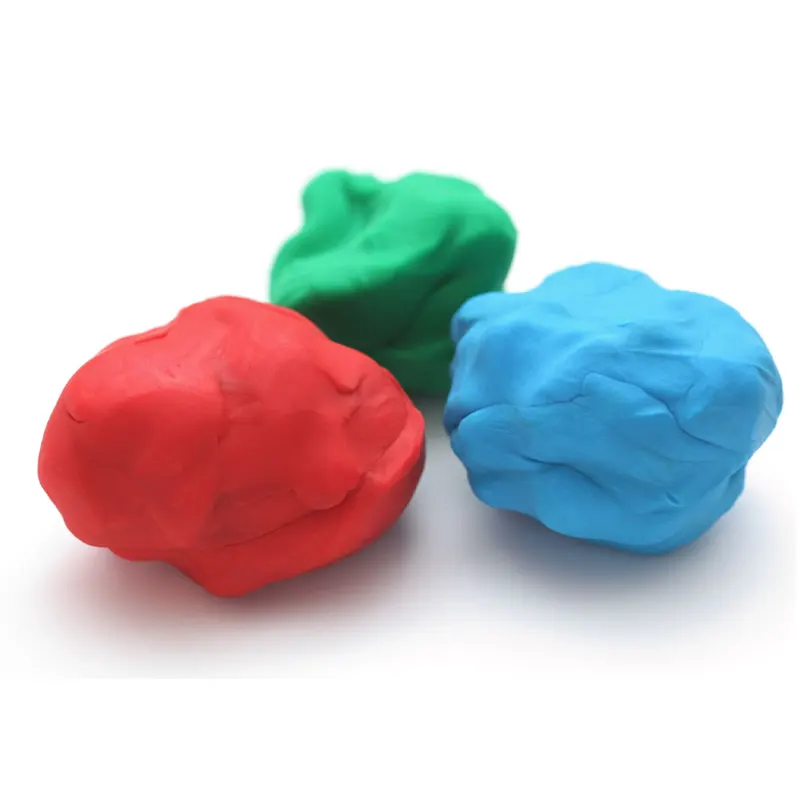
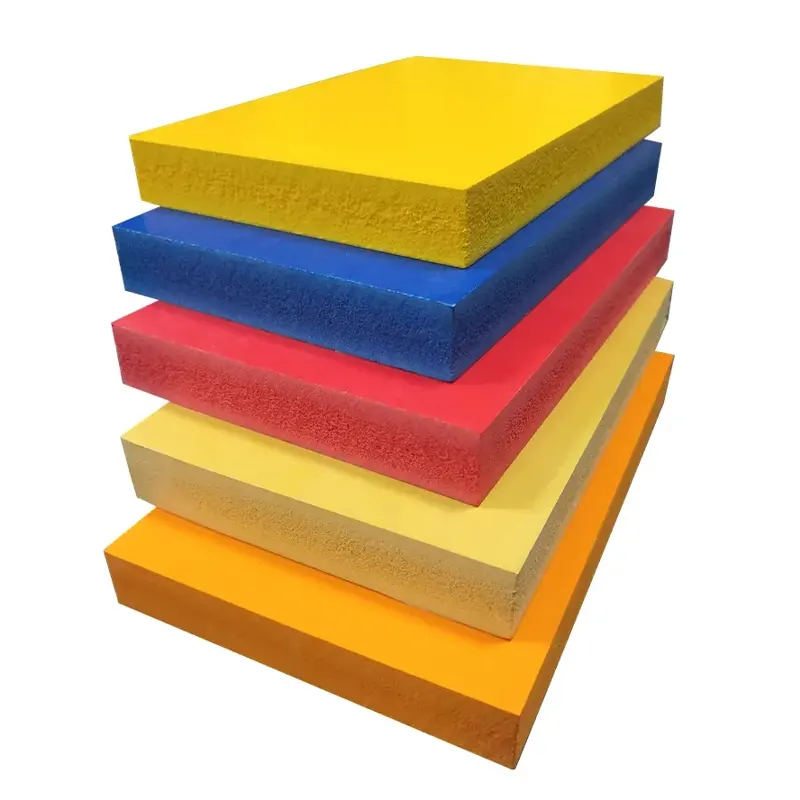
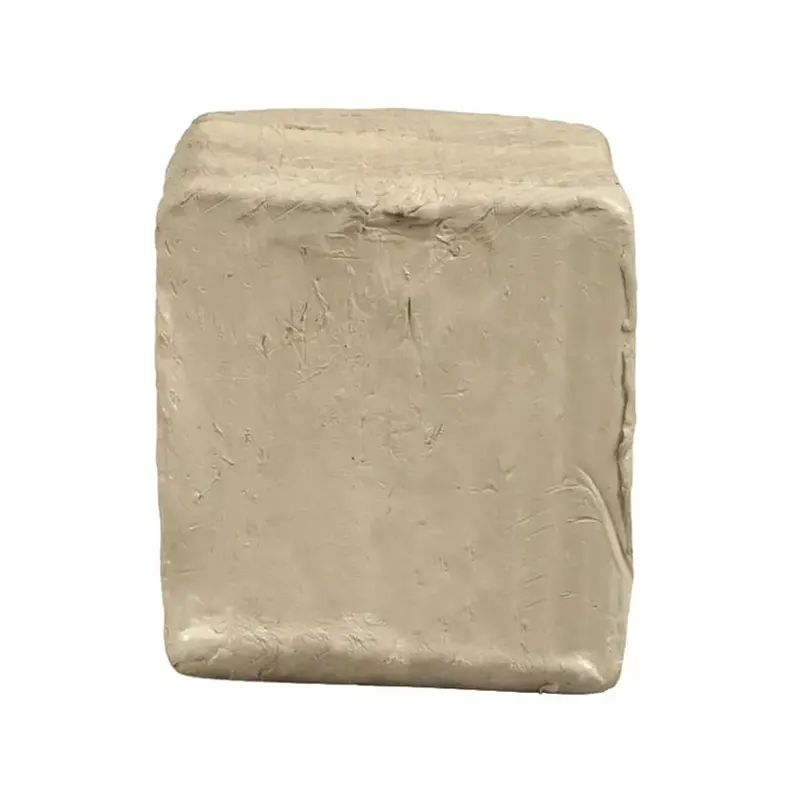
- Playdough: Perfect for molding, rolling, and shaping, fostering hand strength and creativity.
- Clay: Air-drying or traditional clay for creating sculptures and 3D art.
- Foam Sheets: Soft, colorful sheets for cutting and crafting.
- Fabric Scraps: A variety of fabric pieces for collage, texture experiments, and sensory play.
- Buttons: Great for counting, sorting, and using in collages or other creative projects.
- Feathers: Add texture to collages and crafts.
- Sequins: Sparkling additions for embellishments and sensory engagement.
Collage and Craft Supplies
Collage activities offer children the opportunity to combine materials in creative ways. Crafting encourages planning and coordination, and it gives children a chance to express their ideas through hands-on projects.
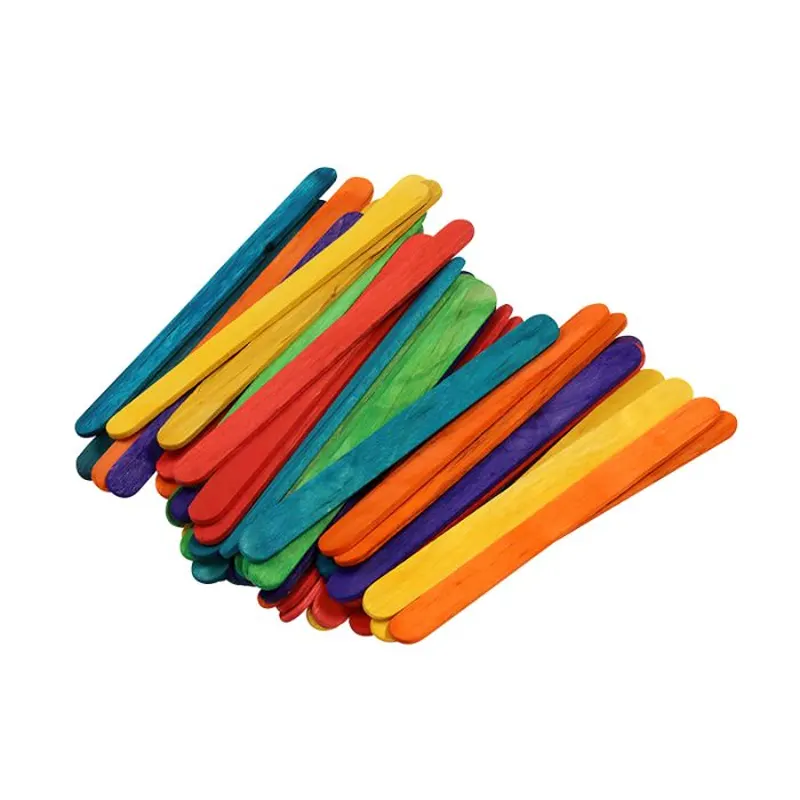
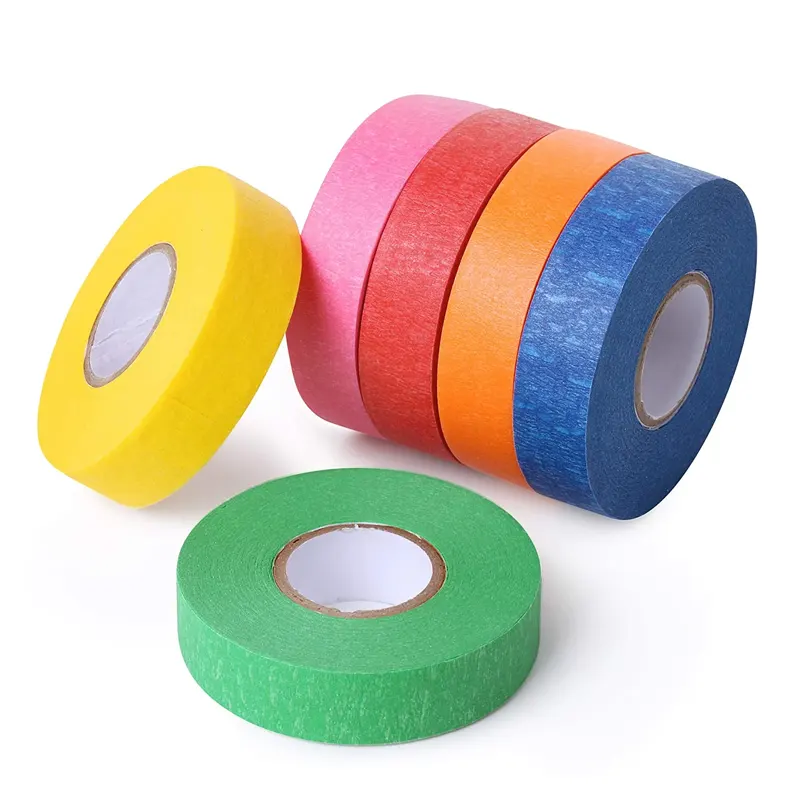
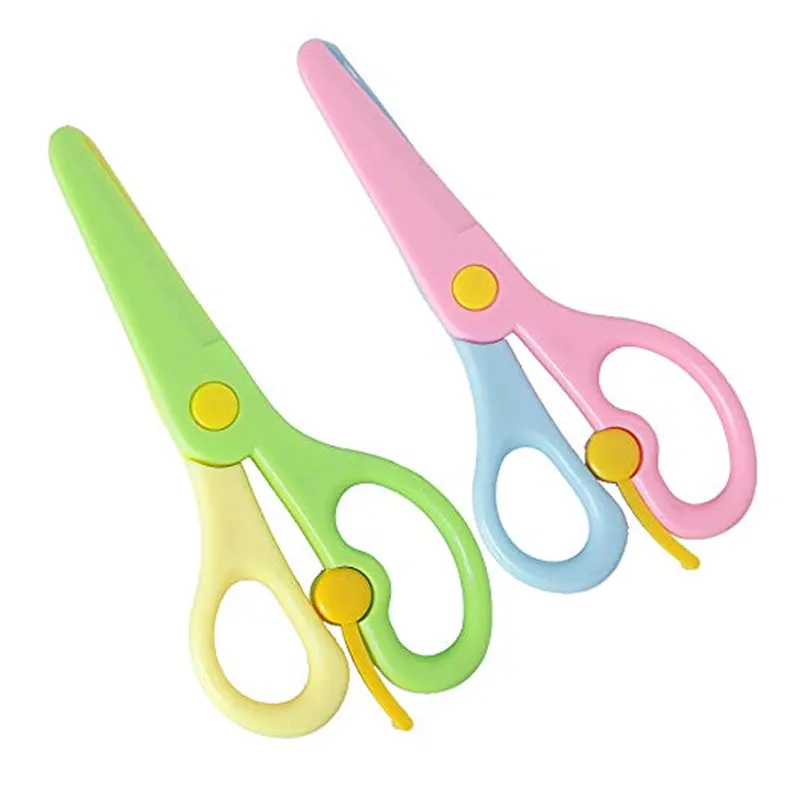
- Glue: Non-toxic liquid glue or glue sticks for sticking materials together.
- Scissors: Child-safe scissors for cutting paper, fabric, and other materials.
- Paper: A variety of papers (tissue, scrapbook, or colored) for creating collages.
- Tape: Masking tape or painter’s tape for sticking materials or marking spaces.
- Craft Sticks: Popsicle sticks for building and creating sculptures.
- Stickers: Fun and themed stickers for embellishing artwork or for use in sensory activities.
Outdoor Art Supplies
An outdoor art space provides children with the freedom to create on a larger scale and explore art in nature. Outdoor art activities encourage gross motor development and are perfect for messy projects that benefit from open space.
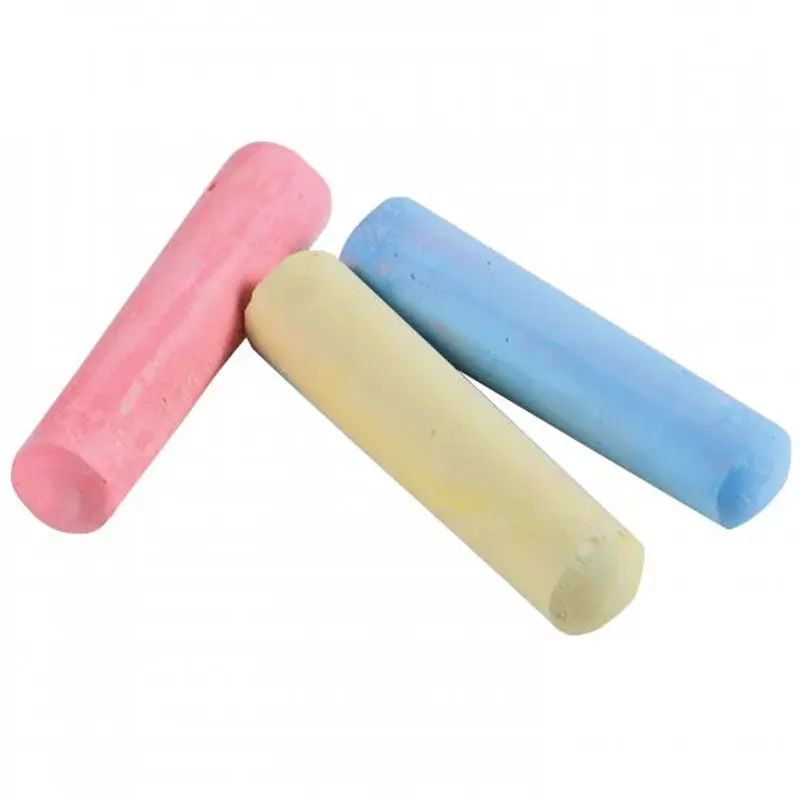
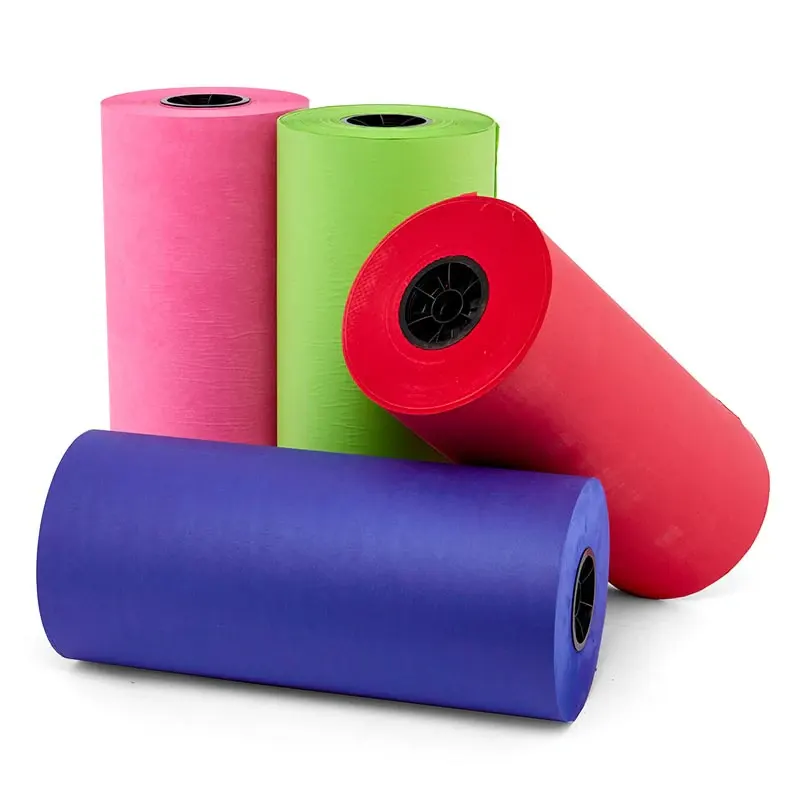
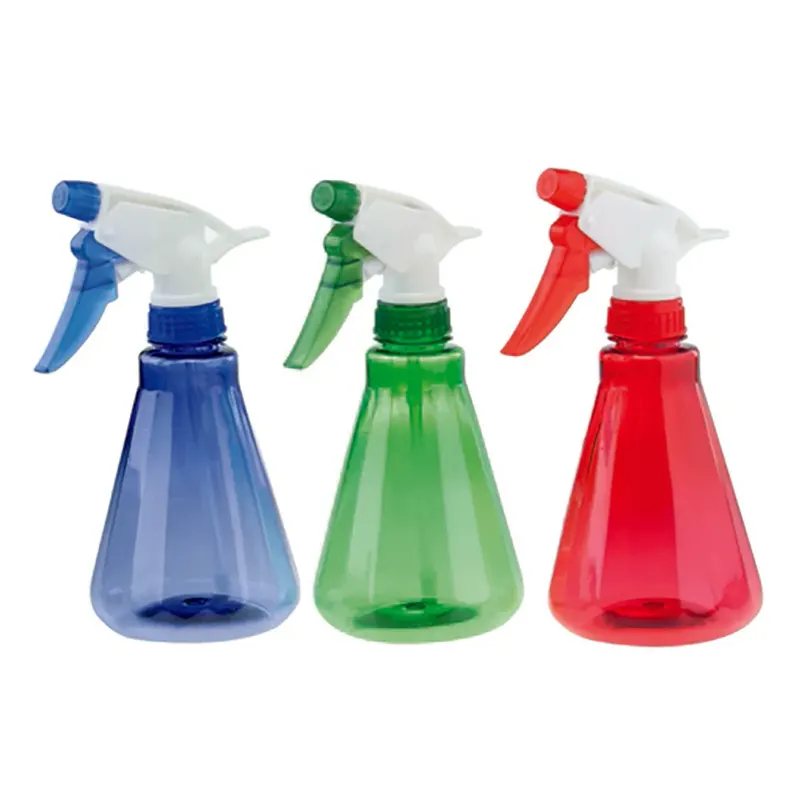
- Sidewalk Chalk: For drawing on sidewalks, playgrounds, or outdoor surfaces.
- Spray Bottles: For spray painting or color mixing.
- Large Paper Rolls: For mural-making or creating large collaborative art projects.
- Outdoor Paints: Washable, weather-resistant paints for creating art outside.
- Nature Materials: Leaves, sticks, rocks, and flowers for nature collages and other outdoor creations.
Storage and Organizational Supplies
A well-organized preschool art center ensures that materials are accessible, manageable, and kept in good condition. Proper storage helps children learn how to care for their supplies and keeps the space tidy and ready for creativity.
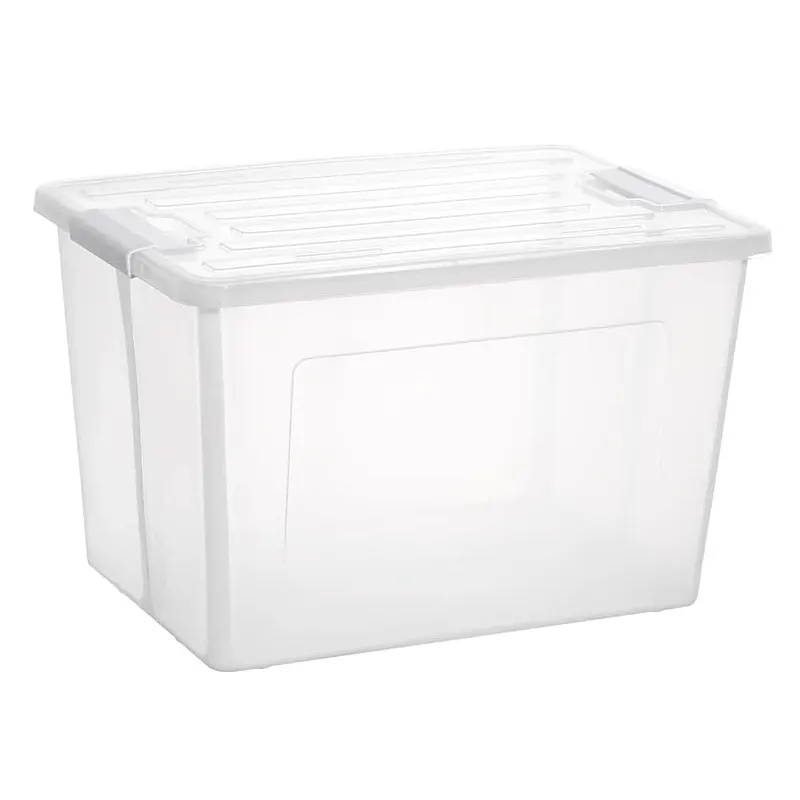
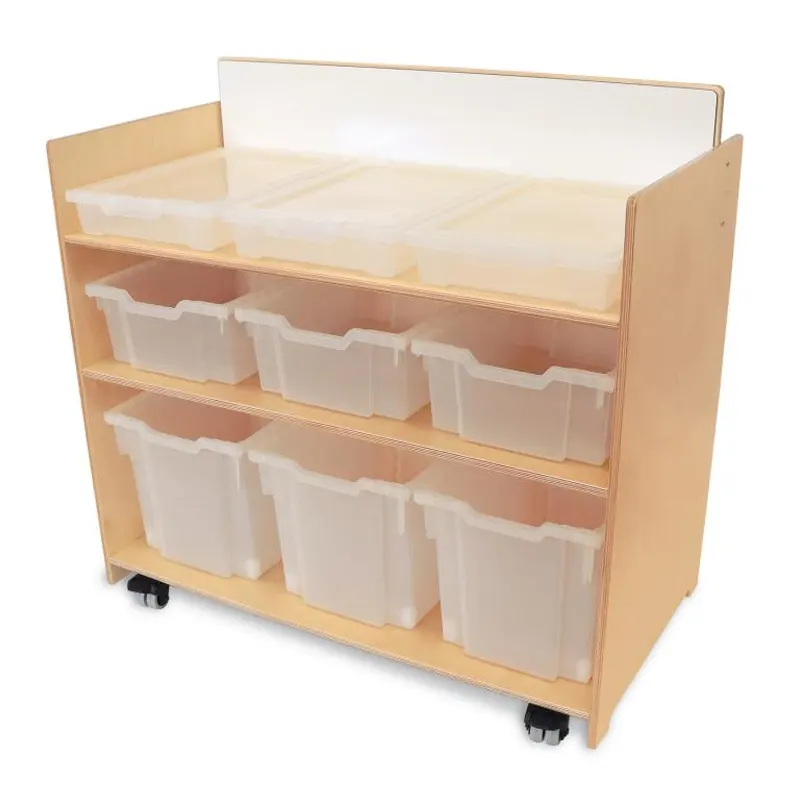
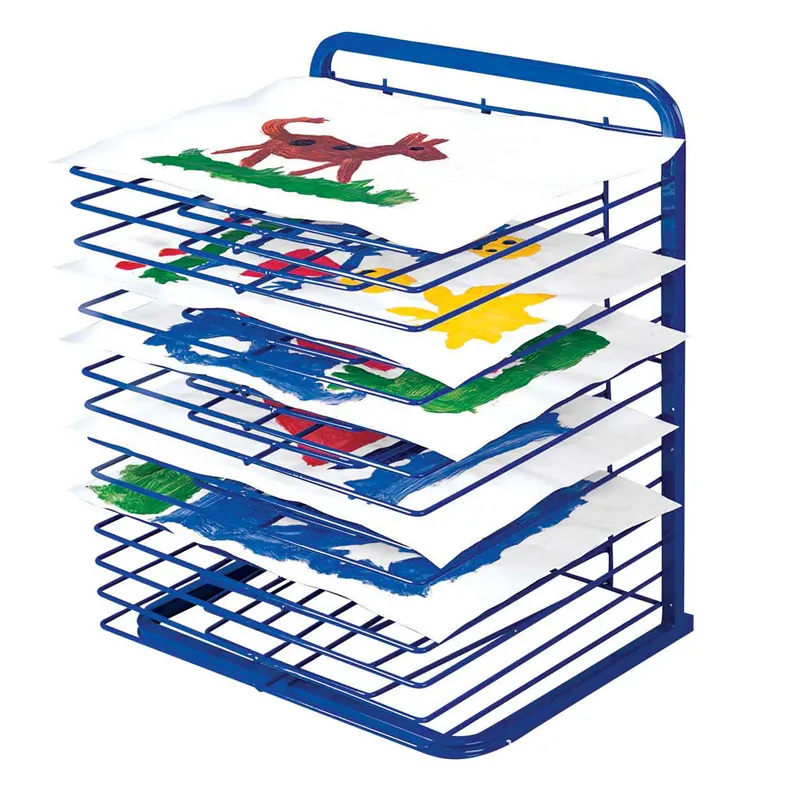
- Clear Bins: For sorting and storing crayons, markers, and paints.
- Chariots roulants: Portable carts to move supplies between areas or classrooms.
- Shelves: Open shelving for easy access to materials.
- Labeled Baskets: For sorting materials by type (e.g., craft sticks, paper, fabric scraps).
- Drying Racks: To store wet artwork and projects while they dry.
- Cubbies: For storing children’s personal art supplies or finished artwork.
Safety and Clean-Up Supplies
Safety is a top priority in the preschool art center, and providing the right materials for clean-up ensures a safe and efficient environment. Keeping everything tidy is an essential part of teaching children responsibility.
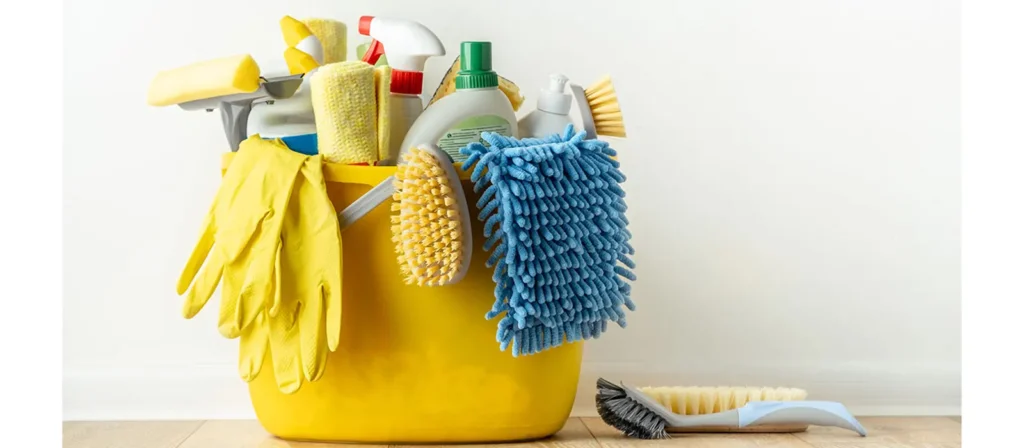
- Smocks: Protective aprons to keep clothes clean during messy art activities.
- Wipes: Baby wipes or disinfecting wipes for quick clean-ups.
- Paper Towels: For drying brushes, cleaning spills, and wiping down tables.
- Broom and Dustpan: For sweeping up small pieces of paper, glitter, and other debris.
- Non-toxic Cleaners: To safely clean surfaces and materials.
- First Aid Kit: To handle any minor accidents or injuries promptly.
Votre salle de classe idéale est à un clic !
Tips for Managing a Preschool Art Center
Managing a preschool art center involves much more than restocking crayons or wiping down tables. It requires intentional planning, child-centered routines, and ongoing support to ensure that creativity flourishes in a safe and organized environment. Below are key strategies to help teachers and caregivers manage the space effectively while encouraging autonomy and artistic exploration.
1. Support Independence with Clear Routines
Preschoolers thrive on predictability. Establishing simple daily routines for using the preschool art center—such as how to select materials, where to sit, and how to clean up—helps children engage with confidence. Use visual schedules or picture cues to reinforce these routines for non-readers.
2. Balance Structure and Creative Freedom
Too much structure can limit creativity, while too little can lead to chaos. Set clear boundaries around material use, safety, and sharing, but keep the creative outcomes open-ended. For example, offer a themed prompt (“Make something from nature”) but allow children to choose their medium and style. Provide a mix of guided and open-choice activities, and be prepared to observe and adapt based on children’s interests and developmental needs.
3. Create a Responsive Environment
A well-managed preschool art center should evolve with the classroom. Rotate materials based on the season, weekly themes, or children’s emerging interests. Refresh the space with new textures, tools, or color palettes to keep creativity flowing. Also, make the environment responsive to children’s needs: add adaptive tools for children with fine motor challenges or offer sensory alternatives like soft clay instead of scissors.
4. Prioritize Safety Without Limiting Exploration
While a creative mess is part of the process, safety, and supervision must remain central. Use only non-toxic, washable materials, and teach proper handling of tools like scissors, staplers, or hole punches.
Introduce cleanup as part of the routine, not just the teacher’s job. Children should learn how to wipe tables, clean brushes, and return supplies. Build these habits into transitions to foster responsibility and pride in maintaining their shared space.
5. Observe, Document, and Celebrate
Effective management includes observation and reflection. Watch how children use materials, how long they stay engaged, and whether they return to the center regularly. These insights help adjust the environment and plan future projects.
Display artwork prominently and respectfully. Create a gallery wall, artist-of-the-week board, or story corner where children can talk about their creations. This honors their work and invites community dialogue.
Role of the Teacher in the Preschool Art Center
| Le rôle de l'enseignant | What It Looks Like in Practice |
|---|---|
| Environment Designer | Organizes space and materials to support independence; rotates tools based on theme or interest. |
| Creative Facilitator | Encourages exploration, asks open-ended questions, supports process over product without giving specific instructions. |
| Observer & Documenter | Watches how children use materials; collects insights through photos, quotes, and behavior for assessment and reflection. |
| Role Model | Demonstrates respect for art, uses materials with care, and celebrates individual styles and approaches. |
Preschool Art Center Rules
A successful preschool art center isn’t just about having the right materials—it also relies on a clear, age-appropriate framework that guides how children interact with the space. Establishing consistent and understandable rules not only promotes safety and responsibility but also empowers children to use the center independently and respectfully.
Why Rules Matter in a Preschool Art Center?
Rules provide structure in a space designed for creative freedom. When children know what is expected of them, they are more likely to explore with confidence and care. Art materials—like scissors, paint, and glue—require thoughtful use, and setting expectations early helps reduce mess, waste, and frustration for both children and teachers.
Key Characteristics of Effective Rules
To be meaningful to preschoolers, the rules should be:
- Simple: Use short phrases that children can understand and repeat.
- Visual: Support each rule with images or symbols for non-readers.
- Positif: Frame rules in terms of what children should do (e.g., “Use gentle hands”) rather than what they shouldn’t.
- Consistent: Reinforce regularly through modeling, reminders, and routine.
Sample Art Center Rules for Preschoolers
Here are a few commonly used, developmentally appropriate rules:
- Take only what you need.
- Use tools and materials safely.
- Keep the art on the paper.
- Ask before using new materials.
- Clean up before you leave.
- Respect everyone’s art.
Displaying and Teaching the Rules
The preschool art center rules should be posted at the entrance or on a wall within the area. Use large, friendly visuals to represent each rule (e.g., a paintbrush next to “Use tools safely”). In the first weeks of school, introduce rules through demonstration and practice. Reinforce them through:
- Role-playing routines
- Positive reinforcement and praise
- Art center “helper” roles to support the responsibility
Making Rules Part of the Creative Process
Instead of treating rules as limitations, frame them as part of being a real artist. Explain that artists take care of their tools, respect other artists’ work, and clean their studios when they’re finished. This perspective helps children take pride in following the rules and builds a culture of care and cooperation in the classroom.
Age-Appropriate Art Activities for Preschoolers
Art activities for preschoolers are more than just fun—they are essential for fostering creativity, fine motor skills, emotional expression, and cognitive development. Whether indoors or outdoors, structured or free-form, art provides young learners with the tools to explore their world, build confidence, and connect with others. Below are several engaging and age-appropriate art activities designed to support various developmental milestones in preschool children.
1. Finger Painting
Finger painting is a perfect introduction to art for toddlers. It engages them through sensory exploration, allows them to make large, bold strokes, and encourages them to get their hands dirty in a creative, non-threatening way.
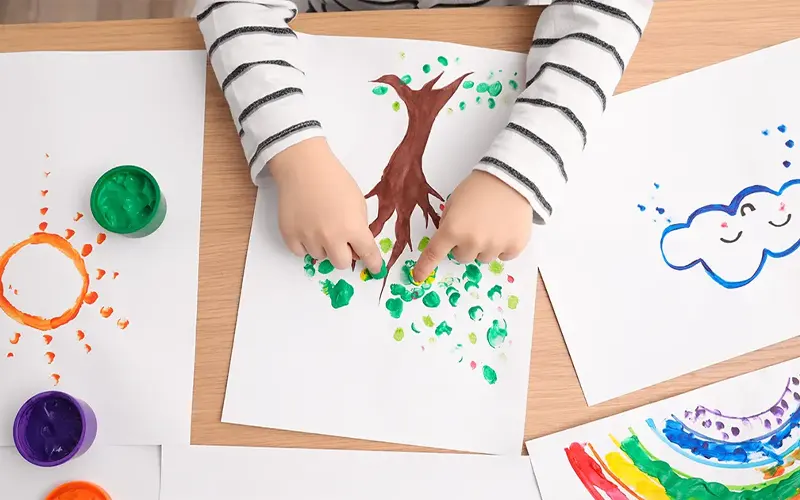
Materials needed:
- Non-toxic washable finger paints
- Large sheets of paper or butcher paper
- Aprons or old T-shirts to protect clothing
Developmental benefits:
- Sensory engagement through texture
- Early motor control development
- Cause and effect understanding: “When I press the paint, it makes marks on the paper.”
2. Nature Collage
A nature collage brings the outdoors into the Preschool art center. Children can collect leaves, flowers, seeds, and twigs and then glue them onto paper to create artwork. This activity helps them connect with nature while developing fine motor skills.
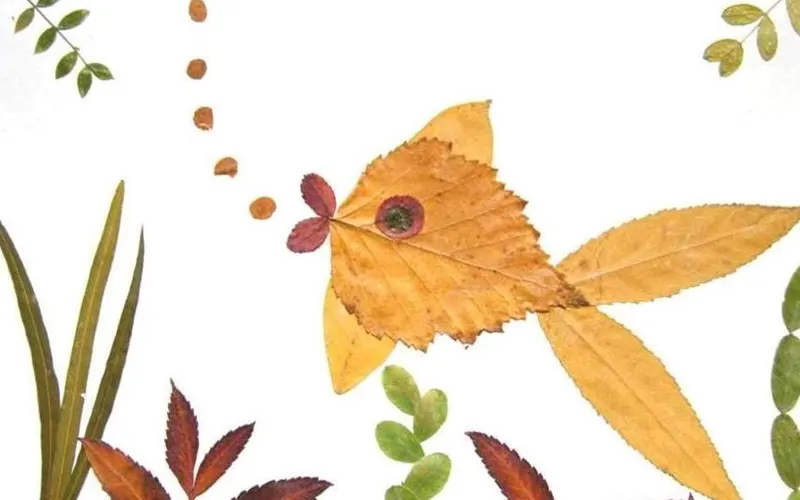
Materials needed:
- Paper (construction paper works well)
- Glue sticks or liquid glue
- Natural materials like leaves, petals, small twigs, seeds, or rocks
- Small brushes for applying glue
Developmental benefits:
- Enhances fine motor coordination
- Encourages observation and appreciation of the natural world
- Supports creativity and abstract thinking
3. Watercolor Resist Art
Watercolor resists art and introduces preschoolers to the concept of texture and layering. This technique involves drawing or painting a design with crayons and then using watercolor paint over the top. The wax of the crayon resists the paint, creating a beautiful design.
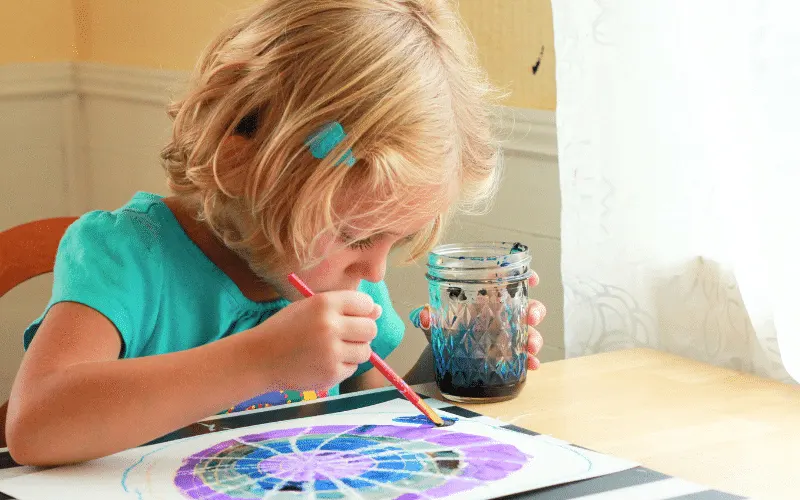
Materials needed:
- White paper or watercolor paper
- Crayons or oil pastels
- Watercolor paints and brushes
- Cups of water and paper towels
Developmental benefits:
- Teaches cause and effect (crayon resists watercolor)
- Develops early art concepts like layering and texture
- Enhances fine motor control through painting and drawing
4. Playdough Sculpting
Playdough provides endless possibilities for creativity. This activity helps children develop both fine and gross motor skills as they manipulate the dough into different shapes, figures, and objects. Sculpting also enhances spatial awareness and cognitive skills.
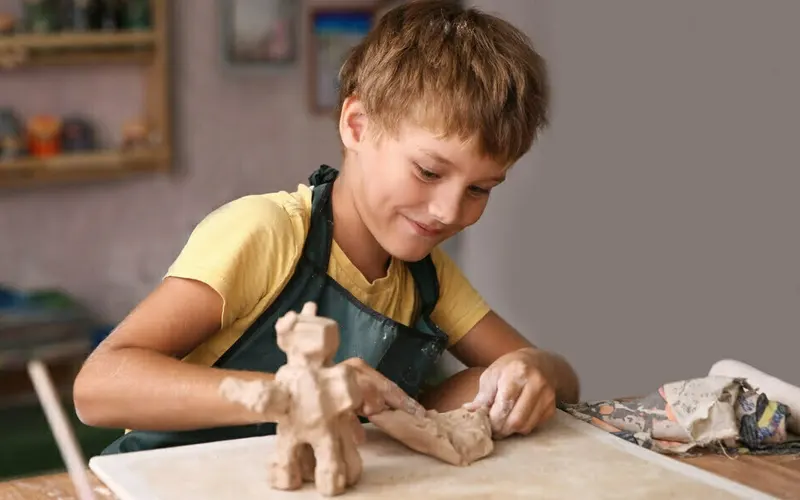
Materials needed:
- Playdough (homemade or store-bought)
- Rolling pins, plastic knives, cookie cutters, and other sculpting tools
- Plastic or wooden trays for sculpting
Developmental benefits:
- Strengthens hand muscles and fine motor skills
- Encourages imaginative thinking and problem-solving
- Provides sensory input through touch and manipulation
5. Paper Plate Masks
Making paper plate masks is an excellent way for children to explore their imaginations and experiment with different materials to create costumes or characters. It combines crafting with storytelling, allowing children to express themselves through art.
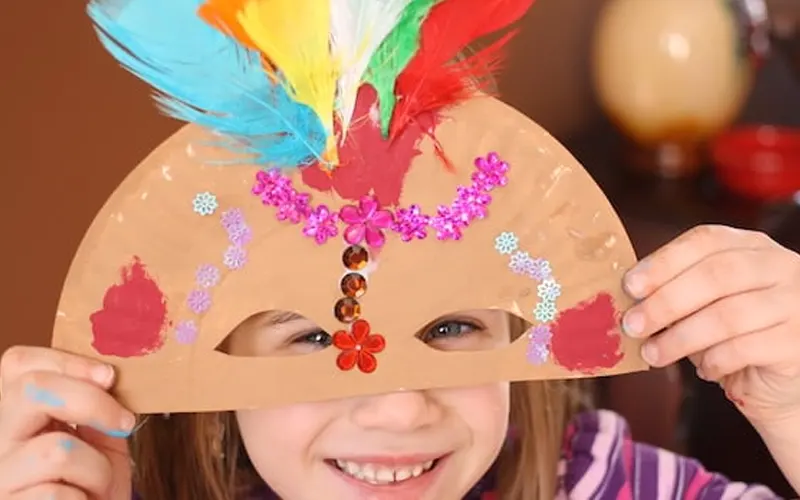
Materials needed:
- Paper plates
- Markers, crayons, paint
- Yarn, glitter, stickers
- Scissors (adult assistance needed)
- Popsicle sticks or string for handles
Developmental benefits:
- Encourages self-expression and imaginative play
- Develops hand-eye coordination through cutting and gluing
- Stimulates creativity and narrative skills through character creation
6. Chalk Drawing on Sidewalks
Sidewalk chalk is an ideal medium for large-scale artwork, and it can be used in various creative ways. Children can make giant murals on the ground, create hopscotch boards, or practice writing their names. This outdoor activity promotes gross motor skills as children bend, stretch, and move across the sidewalk.
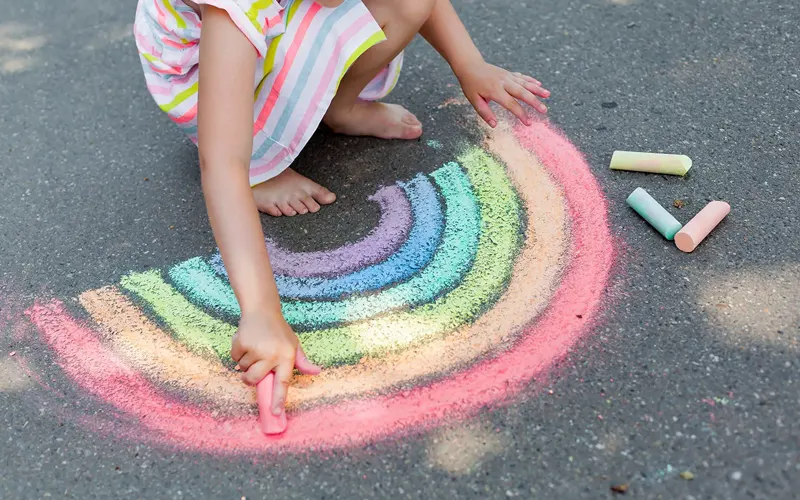
Materials needed:
- Colorful sidewalk chalk
- Outdoor space, like a playground or driveway
- Wet wipes or a hose for cleanup
Developmental benefits:
- Builds gross motor skills through large arm movements
- Encourages creativity and outdoor learning
- Reinforces letter and number recognition for early literacy
7. Collage Art with Recyclable Materials
Using recyclable materials like bottle caps, cardboard, and fabric scraps to create collages teaches children about sustainability while encouraging them to experiment with textures and forms. This activity also helps children understand the importance of reusing materials in creative ways.
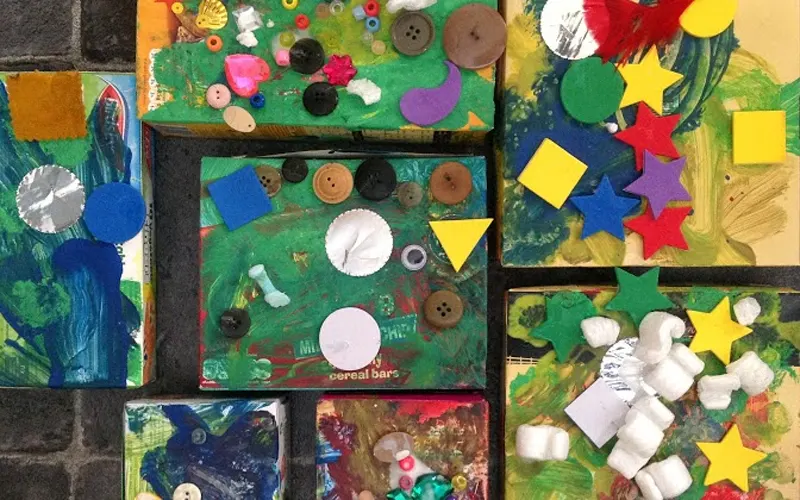
Materials needed:
- Recyclable materials (cardboard, fabric, bottle caps, buttons, etc.)
- Glue or glue guns (for adult use)
- Scissors (for adult use)
- Large sheets of construction paper or cardboard as a base
Developmental benefits:
- Fosters fine motor skills through cutting and gluing
- Encourages creative thinking with alternative materials
- Supports environmental awareness and problem-solving
Ne vous contentez pas de rêver, concevez-le ! Discutons de vos besoins en mobilier sur mesure !
Frequently Asked Questions about Preschool Art Center
- How can I encourage creativity in my preschool art center?
Encourage creativity by offering open-ended art materials like clay, paper, paints, and markers. Avoid overly structured activities, allowing children to explore and express their ideas freely. Ask open-ended questions, like “What can you create with this?” to inspire imagination and creative thinking. - Where can I find preschool art center ideas for creative projects?
If you’re looking for preschool art center ideas, there are many online resources available, such as Pinterest, educational blogs, and YouTube channels. These platforms offer creative and practical ideas that are perfect for setting up an engaging art center and planning fun, age-appropriate projects for preschoolers. - What are some preschool art center ideas for different age groups?
For younger preschoolers (2-3 years old), try finger painting, simple collage making, and exploring textures. For 3-4-year-olds, focus on painting with brushes, stamping, and using scissors. For older preschoolers (4-5 years old), activities like self-portraits, clay sculpting, and themed crafts are excellent choices. - What are the benefits of art for preschoolers?
Art activities for preschoolers help develop fine motor skills, creativity, emotional expression, and problem-solving abilities. They also provide a platform for children to express their ideas, build confidence, and explore sensory experiences. - What is an art center in preschool?
An art center in preschool is a designated space within the classroom where young children can engage in creative activities such as drawing, painting, sculpting, and crafting. It is an environment designed to encourage exploration, imagination, and self-expression through art. - How can I integrate learning themes into the preschool art center?
You can integrate learning themes by choosing art projects that align with current classroom topics. For example, create animal-themed crafts during a unit on animals or explore nature with leaf prints and flower collages during a study of the seasons. This reinforces learning and makes art feel more meaningful. - Can a preschool art center be used for other educational activities?
Absolutely! While primarily focused on art, the preschool art center can also support other areas of development. For example, children can practice math skills by sorting or measuring materials, learn about colors and shapes, and build language skills by describing their artwork.
Conclusion
Creating a well-equipped preschool art center is not just about filling a room with supplies; it’s about providing a rich, stimulating environment that nurtures creativity, fosters developmental growth, and encourages self-expression. The right materials support a wide range of skills—from fine motor coordination to problem-solving, cognitive development, and emotional expression. By offering a diverse selection of art supplies, teachers can inspire children to explore, experiment, and develop a lifelong love for creativity.
At Xiair World World World, as a trusted manufacturer and supplier of children’s furniture and educational toys, we understand the importance of having high-quality, accessible materials in the art center. With over 20 years of experience, Xiair World World World offers a one-stop service that includes everything from the design and customization of mobilier de classe to the supply of educational toys and materials. We ensure that every product we provide is designed with both safety and creativity in mind, supporting the learning and development of preschoolers.
By providing a comprehensive range of carefully curated materials and furniture, Xiair Worldhelps create dynamic, functional art centers that foster creativity, independence, and joy in learning. Our commitment to quality and service makes us the ideal partner in setting up an inspiring and effective preschool art environment.

